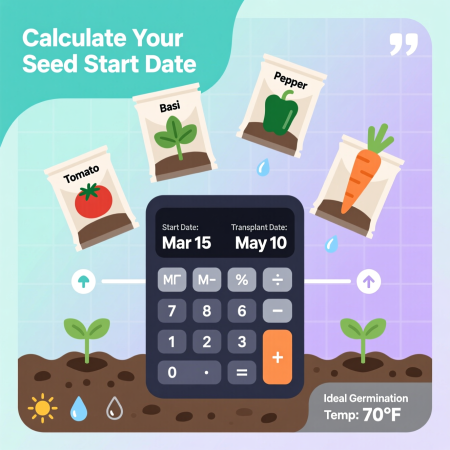🌱 Seed Starting Calculator
| Crop | Start Indoors | Transplant/Direct Sow | Notes |
|---|
Tip: Use row covers to plant earlier or protect tender crops.
🔎 Seed Starting & Sowing Guide
- Choose your last frost date: Enter it above to personalize the plan for your climate. If unsure, search by ZIP code (try online frost date finders for your region).
- Start seeds indoors for crops requiring a long season—tomatoes, peppers, eggplant, broccoli, onions, etc.
- Direct sow outdoors for hardy/quick crops—lettuce, beans, peas, radishes, carrots. These can be planted before the last frost in many areas.
- Harden off seedlings started indoors for a week before transplanting outside (gradually acclimate to outdoor conditions).
- Succession plant fast growers like lettuce, spinach, radish every 2-3 weeks for continuous harvests.
- Check seed packets for variety-specific details and growing times. The table uses typical values for each crop.
- Use a calendar or reminder app to schedule your seed starting and transplanting days!
Guide for Using the Seed Starting Calculator
What it does:
This tool tells you when to start seeds indoors, direct sow, and transplant for a wide variety of vegetable, herb, and flower crops. It uses your local final frost date to personalize the timing, making it perfect for any climate.
How to Use:
- Find your region’s last spring frost date. Use local gardening resources or frost date lookup by ZIP/postal code online.
- Enter the date in the “Final Spring Frost Date” field at the top of the calculator.
- Review the table: The tool will instantly show when to start seeds indoors, outside, or transplant, as calendar dates for each crop.
- Scroll through crop types: Vegetables, herbs, and flowers are included in one table for a complete planning resource.
- Read the notes: See special details for each crop—succession sowing, warmth needs, alternatives, or difficulty rating.
- Adjust for your microclimate: Use row covers, start a week earlier/later if your area is warmer/cooler, or reference your seed packets for specific varieties.
Seed Starting Pro Tips:
- Use quality seed-starting trays and sterile soil for best indoor results.
- Provide strong light for indoor seedlings—use grow lights, south-facing windows, or a greenhouse.
- Harden off indoor seedlings: Gradually expose them to outdoor sunshine and breeze for 5–7 days before transplanting.
- Start succession crops: Re-sow quick crops (lettuce, spinach, radish, bush beans) every 2–3 weeks for continuous harvest.
- Mark your calendar for the next key sowing or transplanting date!

Angelina Everly leads the editorial desk at Live Green Gardens, blending practical plant care, hands-on product testing, and approachable outdoor styling. She focuses on step-by-step how-tos, buyer’s guides, and small-space makeovers that work in real life and real budgets. When she’s not comparing pruning shears or setting up a drip kit, you’ll find her creating cozy corners with planters, solar lights, and pollinator-friendly picks—always with clear pros/cons and safety notes so you can buy once and garden happy.

